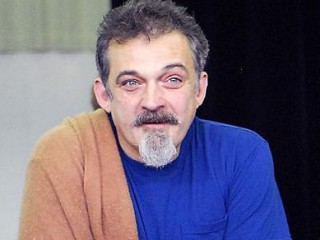
Mark Morris biography
Date of birth : 1956-08-29
Date of death : -
Birthplace : Seattle, Washington, U.S.
Nationality : American
Category : Arts and Entertainment
Last modified : 2011-10-21
Credited as : dancer, choreographer, The Nutcracker
Mark Morris is an American dancer and choreographer, considered probably the most versatile choreographer of the second half of the 20th century.
Mark Morris was born in 1956 in Seattle, Washington. He grew up in a family full of music and dance. His father taught him how to read music. His mother introduced him to flamenco (her favorite dance) at age nine, then to Balkan folk dance and ballet. As a child he created dances for musicals. As a teenager dancing in the Koleda Balkan Folkdance Ensemble, he was already determined to do his own work. His father died when he was in high school, strengthening the bond with his mother. After graduation from high school he spent almost a year in Europe, part of it in Spain, where he continued to study flamenco. Back in Seattle he studied with Verla Flowers and Perry Brunson.
Two years later he showed up in New York. He performed with a diverse assortment of companies over the years, including the Lar Lubovitch Dance Company, Hannah Kahn Dance Company, Laura Dean Dancers and Musicians, and Eliot Fields Ballet. He started creating dances in a rented studio space at the Merce Cunningham Studio in 1980 and then formed the Mark Morris Dance Group, giving concerts. The beginning years were hard, and the dancers had to take on part-time jobs to pay for food and rent. Reactions to his work were strong. Critics called him the "enfant terrible," and he developed a reputation of being an angry young man with his provocative choreographies. The Mark Morris Dance Group was cohesive. He selected his dancers very carefully, choosing individuals of every color and physical description. He cast without regard to race, rank, or sex. He was enormously proud of his dancers' achievements, and they were a constant source of his inspiration.
On a European tour he was "discovered" by the Belgian Mortier, director of the Theatre Royal de la Monnaie in Brussels, who offered Morris the position of director of dance, vacated by Maurice Bejart. Morris accepted, and from 1988 until 1991 he and his dancers worked on regular salaries and in spacious studios. Morris was thrilled to use the resident orchestra and choir for his productions. The three years turned out to be very challenging, as Morris had to content with anti-American sentiment and discrimation because he was homosexual. Although he was very productive, his unhappiness does shine through in a few dark pieces created at the time. (Two examples are "Behemoth", which is performed in silence and "Going Away Party".)
The company was later based in New York, but residencies, such as Dance Umbrella in Boston, required him to live a traveler's life. In 1990 he and Mikhail Baryshnikov founded White Oak Dance Project. This special touring company consisted of dancers from leading ballet and modern dance companies performing many works by Morris.
Morris was tall with a steady frame, copious long curls, and bright blue eyes. He was direct, refreshingly honest, and worked hard and expected the same from his dancers, collaborators, and observers. He was a diverse choreographer and a gifted dancer. His work could be hilarious, shocking, lyrical, raw, beautiful, and satirical, without being vulgar. His choices ranged from popular music of all decades and cultures to religious classical, Vivaldi, and country/western. While choreographing, he held the sheet music, absorbed in the music yet aware of the world outside. He prepared the choreography alone, and in the studio he translated and adjusted his ideas for the dancers. While creating a new dance he sought to perfect the slightest detail, until a dancer felt the emotion, musicality, and rhythm of the movement. The technique he used for his choreographies was eclectic, using different dance styles along with gestures of daily life, performed in a unique and meaningful way. He taught classical ballet in its simplest form. Although he acknowledged that ballet dancers want to defy gravity, as a modern dancer he was constantly challenged by this concept.
In addition to creating over 70 works for his own dance company, beginning in 1980 he also created dances for the Boston Ballet, the Joffrey Ballet, American Ballet Theatre, the Paris Opera Ballet, the White Oak Dance Project, and Les Grands Ballets Canadiens, among others. He also worked extensively in opera, for instance on a new production of "Le Nozze di Figaro." One of his two masterpieces, created while in residence in Brussels, was "L'Allegro, II Penseroso ed II Moderato." It was his first full-length work to Handel's music of the same name and based on poems by John Milton. Twenty-four dancers weave movement, music, and text together with tenderness and ingenuity. This piece was considered Morris' transition from "enfant terrible" to "true artiste". The second masterpiece was "The Hard Nut," a modern mockery of the conventional Christmas Ballet, "The Nutcracker," with the Tchaikovsky score. Morris' version was placed in the 1960s, breaking through cliches by letting all his dancers, men and women alike, wear tutus in the famous snowflake scene. The movements and gestures are drawn from modern and Indian dance, European folk dance, and sign language for the deaf. The diversity of Mark Morris was nearly legendary.
Morris was proclaimed by critics and audiences as "his generation's one and only." He was often mentioned in the same breath with Balanchine. Granted a Bessie Award for choreographic achievement in 1984, he received a Guggenheim fellowship in 1986 and was named a fellow of the MacArthur Foundation in 1991. He recieved the Capezio Dance award in April 1997. By 1995, the Mark Morris Group was the fourth largest modern dance troupe in the United States, with an annual budget of two million dollars.
















